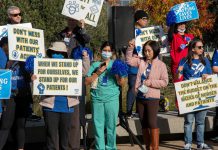By Zachary Smith
Nasty stuff has a nasty habit of sticking around. Though the
U.S. Environmental Protection Agency banned DDT in 1972, the toxic
pesticide’s legacy remains today. Water quality monitors at the
Monterey Bay National Marine Sanctuary pick up traces of DDT every
year, particularly after winter storms that increase soil
runoff.
By Zachary Smith
Nasty stuff has a nasty habit of sticking around. Though the U.S. Environmental Protection Agency banned DDT in 1972, the toxic pesticide’s legacy remains today. Water quality monitors at the Monterey Bay National Marine Sanctuary pick up traces of DDT every year, particularly after winter storms that increase soil runoff.
Pesticide runoff is one of several persistent effects that agriculture has on the water quality of central California’s coastal environment. Constant runoff of fertilizers and soil can effect the Bay’s vitality – when a chemical such as nitrogen enters streams that flow into the Bay, algae growth flourishes, which depletes oxygen levels for other forms of life, such as salmon and steelhead. But thanks to collaborative efforts between farm bureaus and local government agencies overseeing agricultural operations in Santa Clara, San Benito, Santa Cruz, Monterey and San Mateo counties since 1999, runoff into the Bay has been drastically reduced. Erosion control measures have prevented close to 260,000 tons of soil per year from entering the Bay – that’s the equivalent of a football field of soil 11 stories high – and that’s good for farmers and the environment.
“The approach is unique,” said Rachel Saunders, a spokeswoman for the Monterey Bay National Marine Sanctuary. “We can enhance water quality while sustaining agriculture as the economic engine of the region.”
The key is attacking the problem at its source, upstream. “The ocean is downhill and downstream from everything we do,” Saunders said. The sanctuary has set up 23 watershed working groups that plan and install devices to reduce runoff at farms, with roughly 400 ranchers and farmers participating.
The collaboration also enjoys congressional support from Rep. Sam Farr, D-Calif., who has helped secure grant and technical assistance for the farmers.
While the watershed working groups continue to find “hotspots” of declining environmental quality in the streams that feed the Monterey Bay, its overall health is good, Saunders said, thanks to the large amount of mixing in the dynamic water body.













